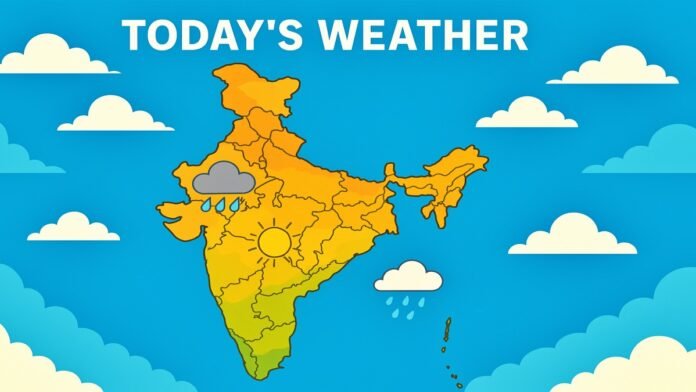
Key Points:
- Extremely heavy rainfall alert issued for Odisha on October 2, with red alert in place
- Bay of Bengal depression formed on October 1, expected to intensify and cross Odisha-Andhra Pradesh coast by October 3
- Western disturbance to affect Northwest India from October 5-7, with peak intensity on October 6
- Heavy snowfall expected in Jammu & Kashmir, Himachal Pradesh, and Uttarakhand from October 5-7
- Delhi-NCR to experience light showers on Dussehra with temperatures dropping to 34°C
- Wind speeds may reach 40-60 km/h across multiple states with thunderstorm warnings
- Above-normal rainfall predicted for October 2025, 15% more than usual across India
- Hailstorm alerts issued for Rajasthan, Punjab, Haryana, and Western UP on October 6-7
New Delhi: The festive spirit of Dussehra has been dampened across India as the country experiences a sudden and dramatic shift in weather patterns. The India Meteorological Department (IMD) has issued multiple warnings for heavy to extremely heavy rainfall across eastern and northwestern regions from October 2 to October 7, 2025, potentially disrupting celebrations and daily life in numerous states.
According to the latest IMD bulletins released on October 1, 2025, a well-marked low-pressure area over the west-central Bay of Bengal has intensified into a depression, with the associated cyclonic circulation extending up to 9.6 kilometers above mean sea level. This system is expected to further strengthen into a deep depression and cross the south Odisha-north Andhra Pradesh coast during the early morning hours of October 3.
Red Alert Issued for Eastern India
The IMD has placed eastern India under a red alert, with Odisha facing the most severe threat of isolated extremely heavy rainfall on October 2, 2025. The Alipore Regional Meteorological office has warned that coastal districts of South 24 Parganas and Purba Medinipur in West Bengal will experience heavy to very heavy rainfall, particularly during the evening of October 2 and morning of October 3.
Jharkhand is expected to receive light to moderate rain with heavy showers at isolated places from October 2 to 4, with particular concerns for mining regions and hilly terrain where soil erosion and localized flooding pose significant risks. Gangetic West Bengal and Chhattisgarh are also likely to experience similar weather patterns during this period.
Northeastern States Brace for Prolonged Rainfall
The northeastern region of India will not escape the weather onslaught, with very heavy rainfall expected in Assam and Meghalaya over the next three to four days. An upper air cyclonic circulation has been observed over northeast Assam and central Assam at lower tropospheric levels, contributing to the sustained rainfall activity in the region.
Sub-Himalayan West Bengal & Sikkim are forecast to receive light to moderate rain with isolated heavy rainfall from October 1 to 6, according to the IMD’s seven-day forecast.
Delhi-NCR and North Indian Plains Experience Weather Relief
The weather has undergone a noticeable change in the plains of North India, bringing much-needed relief from recent high temperatures and humid conditions. Delhi-NCR experienced heavy rain on Tuesday morning accompanied by gusty winds, though it also caused traffic jams and waterlogging in several parts of the capital and surrounding areas.
On Dussehra (October 2), Delhi is expected to witness light showers with a maximum temperature of 37°C and minimum of 25°C, with a 64% chance of rain and passing showers. The IMD has issued a yellow alert for Delhi-NCR with very light rainfall expected. IMD scientist Naresh Kumar confirmed that overcast skies will continue on October 3, 4, and 5, with another spell of heavy rain possible on October 6 as dark clouds gather again.
Eastern Uttar Pradesh has been warned to expect rain from October 3 to 6, while Bihar faces a serious alert for heavy rain, strong winds reaching 40-50 km/h, and thunderstorms between October 3 and 5.
Intense Western Disturbance to Impact Northwest India
A fresh and intense western disturbance is set to affect northwest India from October 5, with the most severe impact expected on October 6 and 7, 2025. This weather system will bring significant changes to the mountainous and plain regions of northern India.
The hilly areas of Jammu and Kashmir, Himachal Pradesh, and Uttarakhand are bracing for heavy rain and substantial snowfall during this period. This early snowfall could impact tourism and transportation in these regions, particularly affecting higher altitude areas.
Hailstorm Warning for Rajasthan and Northern Plains
The IMD has issued specific warnings for hailstorms accompanied by thunder and lightning in several states. Rajasthan is expected to face heavy rain and hailstorms on October 5 and 6, while Punjab, Haryana, and Western Uttar Pradesh have been placed under similar alerts for October 6 and 7. Residents in these regions have been strongly advised to remain alert and take necessary precautions during outdoor activities.
Heavy to very heavy rainfall was already recorded at isolated places over West Uttar Pradesh and East Rajasthan in the past 24 hours till 0830 hours IST on October 1, indicating that the weather system is already active.
October 2025: Above-Normal Rainfall Expected
In a significant meteorological development, IMD Director General Mrutyunjay Mohapatra announced on September 30 that India is expected to receive 15% more rainfall than normal in October 2025, following bountiful rains during the four-month monsoon season. The country is likely to receive above-normal rainfall in October, exceeding 115% of the long period average (LPA) of 75.4 mm.
Mohapatra attributed this unusual rainfall pattern to the development of low-pressure systems in the Bay of Bengal and Arabian Sea, along with intra-seasonal variability and other large-scale atmospheric processes. Maximum temperatures in October are likely to be above normal in most parts of east-northeast and northwest India, creating warm and humid conditions alongside the rainfall.
Twin Weather Systems Delay Monsoon Withdrawal
The formation of twin low-pressure systems over the Arabian Sea and Bay of Bengal has delayed the withdrawal of the southwest monsoon from several parts of India. As of September 30, the monsoon has departed from only 12 districts, significantly behind schedule. The continued presence of these weather systems is driving widespread rainfall activity across the country.
A well-marked low-pressure area over the northeast Arabian Sea and adjoining Saurashtra coast was centered at 0830 hours IST on October 1, 2025, and is likely to move nearly westwards and intensify into a depression. A trough runs from this cyclonic circulation to southwest Uttar Pradesh across east Rajasthan at lower tropospheric levels, further contributing to the widespread rainfall.
Safety Advisory and Precautions
Given the severity and widespread nature of the weather warnings, authorities have advised residents and travelers to exercise extreme caution, especially in coastal, hilly, and riverine districts. The heavy rainfall poses risks of flash floods, river swelling, waterlogging, and urban flooding in vulnerable areas. Agricultural communities have been particularly warned, as kharif crops are close to harvest in many regions, especially in Bihar’s northern districts.
Transportation disruptions are expected across multiple states, with particular concerns for hill roads in northern states where landslides may occur. The IMD continues to monitor both weather systems closely and will issue updated warnings as conditions evolve.

















































